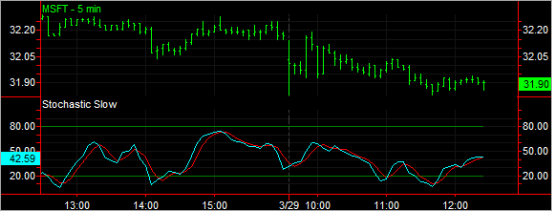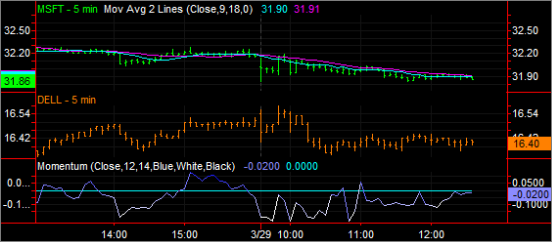
TradeStation Help
The y-axis displays values on the left or right side of the chart that are specific to the symbol or analysis technique when applied to the chart. By default the y-axis is located on the right side of the chart, however, you have the option to display it on the chart's left side or not have it appear on the chart at all. This is helpful when you want to display an indicator's scale on one side and the symbol's scale on the other, or when overlaying two symbols on the same sub-graph.
You can display two y-axis scales in a chart when overlaying an indicator on price data and uses a different scaling than the symbol applied to the chart. For example, if you overlay the Stochastic Slow indicator on a MSFT chart, for easier viewing you can display the left side y-axis to display the indicator's values and the right side y-axis to display Microsoft's price.

If you decide you want more than one symbol and analysis techniques appear in the same subgraph, you can choose which scale you want to appear in the left or right y-axis. This is helpful when you want to display an indicator's scale on one side and the symbol's scale on the other or when overlaying two symbols on the same sub-graph.
For example, if MSFT and DELL are applied to a chart each with an analysis technique plotted to each symbol, you can display the Microsoft price on the left side and have Dell's price appear on the right side of the y-axis.

To determine the price of a bar or analysis technique, you compare the height of the bar (or analysis technique) with the values shown on the y-axis. There are three types of ranges for scaling you can select from: Date Range on Screen, Entire Date Range, or Percent Below/Above Last.
![]() For
more information on formatting the scaling settings for a symbol, see Format Symbol - Scaling. For more information on formatting the scaling settings for an analysis technique, see Format Analysis Technique- Scaling.
For
more information on formatting the scaling settings for a symbol, see Format Symbol - Scaling. For more information on formatting the scaling settings for an analysis technique, see Format Analysis Technique- Scaling.